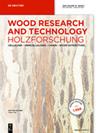采用阻燃浸渍和致密化处理相结合的方法将樟子松加工成隔热、热稳定、阻燃材料
IF 1.6
3区 农林科学
Q2 FORESTRY
引用次数: 0
摘要
摘要阻燃浸渍和致密化是提高木材防火安全性的两种主要改性技术。在此,将这两种技术结合起来制备阻燃木材,旨在进一步减少火灾危害。用硼酸(BA)和氧化石墨烯(GO)溶液对脱木素的樟子松(Pinus sylvestris L.)进行浸渍,然后进行致密化处理,制备了致密化阻燃木材BGO-DW样品。结果表明,BGO-DW样品的极限氧指数(LOI)值为47.4 %. 1200后的背面温度 s加热49 % 低于未改性木材。此外,BGO-DW样品的峰值放热率(PHRR)和总放热率(THR)分别为72和62 % 热重分析(TG)支持的是,由于其较短的热解间隔和较低的峰值质量损失率(PMLR),因此低于未改性木材。BGO-DW样品的阻燃性可归因于形成了含有C=C芳香结构、C–O–C交联结构和三氧化硼(B2O3)结构的相容性炭。BGO-DW样品的这些特性为提高木材和木质产品的热稳定性、隔热性和阻燃性提供了一种新的方法。本文章由计算机程序翻译,如有差异,请以英文原文为准。
Processing of Pinus sylvestris L. into a heat-insulating, thermally stable, and flame-retarded material by combining the flame-retardant impregnation and densification treatment
Abstract Flame-retardant impregnation and densification are two major modification techniques to improve the fire safety of wood. Here, these two techniques were combined to prepare flame-retarded wood, aiming at further fire hazard reduction. The delignated Pinus sylvestris L. was impregnated with boric acid (BA) and graphene oxide (GO) solutions, then densified to prepare densified flame-retarded wood named BGO-DW sample. The results revealed that the BGO-DW sample obtained a limiting oxygen index (LOI) value of 47.4 %. Its backside temperature after 1200 s heating was 49 % lower than that of unmodified wood. Besides, the peak heat release rate (PHRR) and total heat release (THR) values of BGO-DW sample were 72 and 62 % lower than those of unmodified wood due to its shorter pyrolysis interval and lower peak mass loss rate (PMLR), as supported by thermogravimetric (TG) analysis. The flame retardancy of BGO-DW sample could be attributed to the formation of compatible char containing C=C aromatic structure, C–O–C cross-linked structure, and boron trioxide (B2O3) structure. These features of BGO-DW sample offer a new method to improve thermal stability, heat insulation, and flame retardancy for wood and wood-based products.
求助全文
通过发布文献求助,成功后即可免费获取论文全文。
去求助
来源期刊

Holzforschung
工程技术-材料科学:纸与木材
CiteScore
4.60
自引率
4.20%
发文量
83
审稿时长
3.3 months
期刊介绍:
Holzforschung is an international scholarly journal that publishes cutting-edge research on the biology, chemistry, physics and technology of wood and wood components. High quality papers about biotechnology and tree genetics are also welcome. Rated year after year as one of the top scientific journals in the category of Pulp and Paper (ISI Journal Citation Index), Holzforschung represents innovative, high quality basic and applied research. The German title reflects the journal''s origins in a long scientific tradition, but all articles are published in English to stimulate and promote cooperation between experts all over the world. Ahead-of-print publishing ensures fastest possible knowledge transfer.
 求助内容:
求助内容: 应助结果提醒方式:
应助结果提醒方式:


